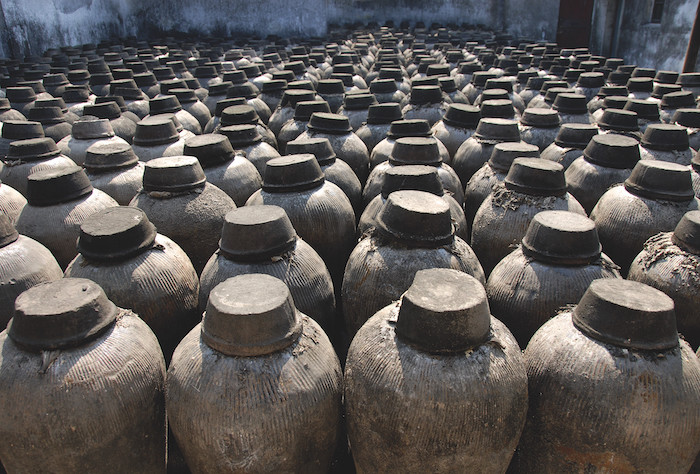
Benjamin Salguero, baijiu specialist and co-owner of Bristol’s Golden Crane and Jaded Dragon, provides the explainer on the colossal Chinese spirit, baijiu.
What is baijiu? Baijiu (pronounced ‘byejyo’) is both a new and ancient spirit from mainland China. The word baijiu translates directly into ‘white alcohol’ and is deeply intertwined with social etiquette, spiritualism, religion and creative distillation. This results in a multitude of variations of styles (known as ‘aromas’) within the category. Some of these aromas are so specific in their creation that they are associated with just a single distillery in China.
As a result, it is hard to produce a simple description that defines baijiu and encapsulates how it is made. At every step of baijiu creation, there is always an exception to the rule. However, it is possible to make general statements about the spirit and how it is made.
The raw material used in all baijiu is grain. The most common base grains are sorghum and rice. However, complex mash bills include wheat, corn, barley or starch grain.
Fermentation is the key to baijiu’s flavour. Using cultivated fungi and bacteria known as qu (pronounced ‘chew’), pits dug into the ground are traditionally utilised to ferment the (solid-state) grain with the qu over weeks or months. This fermentation style increases esterification and results in heavy, pungent flavours without water.
The natural wild yeast in the air impacts the solid ferment, adding to baijiu’s sense of terroir. Due to differing environments, even distilleries that are located side by side can create the same product with different flavours.
Following the solid-state fermentation, traditionally, a Chinese still called a zengtong is used to distill the alcohol compounds produced from the fermentation. Batches of grain are added to the still, which acts like a dim sum steamer. Steam is forced evenly through the grain, carrying the alcohol compounds with it until it condenses into a liquid at around 70% abv through a single distillation run.
Following the distillation, baijiu is left to age in breathable earthen jars, allowing it to carry on interacting with itself and the environment through oxidation. This process enables the distillate to continue esterification to build complex flavours even after distillation. These are typically aged for six months and up to 15 years or more.
The final stage of baijiu production is blending. It’s rare to find single-jar bottlings, as the key to baijiu flavour is blending different years and flavour compounds. Each batch of ferment and distillation can and will result in different flavours due to the interaction of wild yeast, fungi and bacteria, depending on various temperatures, starch sugars and length of time. These are then typically blended to around 53% abv.
The aromas
Due to the powerful influence of terroir in baijiu production, there is no one through line of flavour from each aroma style. However, each one does have a traditional expectation of flavour, even if there are no two similarly flavoured brands. It’s important to note that the names of the aromas refer to location or production, not the end product.
The four major aromas are:
Strong aroma: Traditionally made in Sichuan, this aroma is typically tropical in flavour, with notes of pineapple, guava, passion fruit, cardamom, aniseed, peppercorn and blue cheese.
Sauce aroma: Traditionally made in Guizhou, this aroma is typically complex in flavour, with notes of Marmite, soy sauce, nuts and dark chocolate.
Light aroma: Traditionally made in Shanxi or Beijing, this aroma is typically vegetal in flavour, with notes of sesame, bell peppers, sprouts and white chocolate.
Rice aroma: Traditionally made in Guangdong or Guangxi, this aroma is typically lighter in flavour with notes of melon, nori, honeysuckle and manuka honey.
Additionally, there are nine minor aromas: phoenix, sesame, fat, special, mixed, laobaigan, small qu light, extra strong and medicine. Alongside these 13 aromas are regional sub-groups and infusion styles, resulting in a considerable amount of baijiu unique to each province.
Baijiu in the UK
Of the four major styles, three are easily accessible for UK bartenders and bars to delve into:
• Strong aroma: Ming River from Luzhou Laojiao

• Sauce aroma: Prince Gold from Kweichow Moutai
• Light aroma: Fen Chiew Brown from Xinghua Cun Fenjiu
Baijiu can be challenging to work with as a cocktail ingredient because of the higher abv, pungent flavours and unique varieties, even between the same aromas. A lot of the time, you can’t just use two different baijius for the same drink – unlike, for example, two different rums for a Daquiri – without getting a wildly different outcome.
That being said, a little reworking of volumes of liquid can go a long way with using baijiu in classic cocktails. The key is understanding that less is more with this spirit, as those robust flavours and abv travel far.
Here’s how I approach classics with baijiu.
Strong aroma: This works well in rum drinks – Daiquiri as an example. Changing the spirit to 40ml instead of 50ml. Using 30ml lime and 20ml sugar balances the drink, unlike the standard 25ml lime and 25ml sugar.
Light aroma: This works well in gin drinks – the example here is Negroni. The balanced spec for a Bai-groni would be: 30ml baijiu, 15ml Campari and 30ml sweet vermouth. The reduced Campari allows the spirit to breathe while the vermouth emphasises the botanical flavours.
Sauce aroma: This works well in whiskey drinks – an example is the Old Fashioned. Using 55ml of baijiu with three dashes of chocolate bitters, 15ml of honey for the sugar and finish with lemon zest to open up the core flavours.
Outside of classic cocktails, baijiu is wonderful for original or signature drinks, mixing as a highball, looking at savoury cocktails with tannic tea flavours such as jasmine and bergamot, or going extreme with Marmite or Scotch bonnet.
BAIJIU HISTORY
Baijiu, as we know it, was classified in 1952 and has seen some revisions since it developed into the four major and nine minor aromas we know today. However, baijiu's history spans around 3,200 years, with distilled alcohol discovered in China during the Shang dynasty at approximately1200BC.
Distillation stills were found from the Han dynasty of 206BC-25AD. Multiple poets in China wrote about distilled alcohol throughout the early Common era, 100AD1000AD, and the rise of mainstream distilled alcohol throughout mainland China spread through the Yuan dynasty, 127AD-1368AD.
Over the next 600 years, the four major aromas of baijiu would be fleshed out and developed until we reach the modern classification. Historically, baijiu was known as shaojiu (pronounced ‘shaal gio’, meaning ‘burnt alcohol’). It took the name baijiu when the individual regional spirits were brought together under one banner by the People’s Republic of China.
» Follow Ben at @Baijiu_with_ ben


